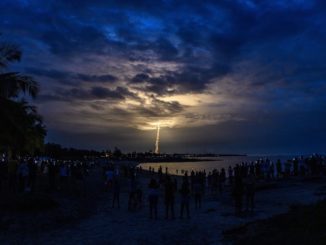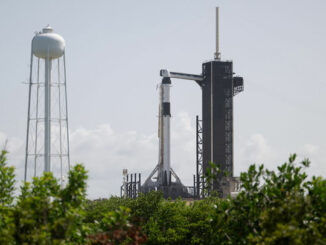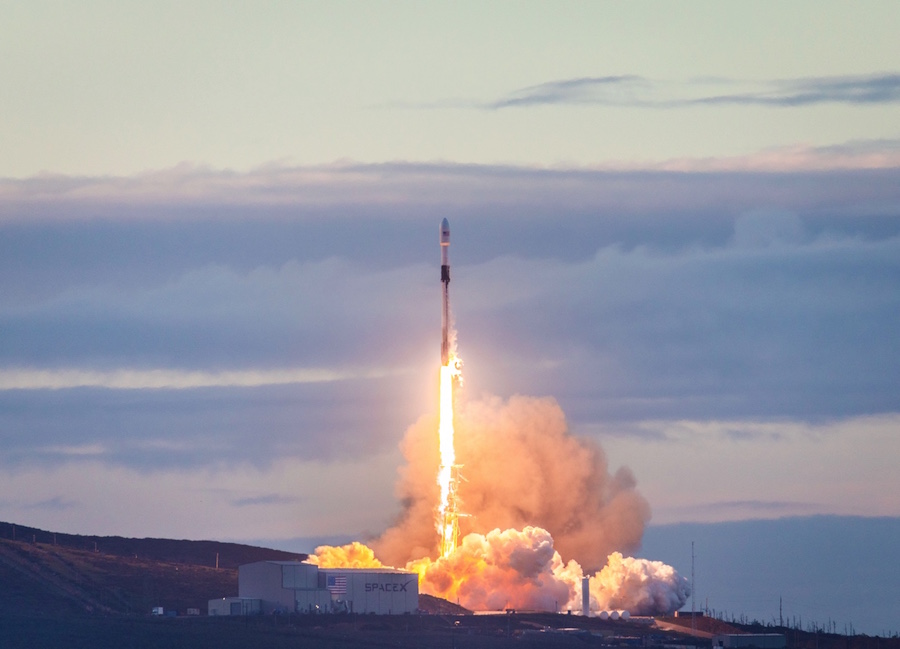
Ten Iridium communications satellites rode a Falcon 9 rocket into orbit Friday from California in the eighth and final launch for Iridium’s upgraded network over the last two years, and the first of around 18 predicted SpaceX missions planned in 2019.
The 229-foot-tall (70-meter) Falcon 9 rocket lit its nine Merlin 1D main engines and climbed away from Space Launch Complex 4-East at Vandenberg Air Force Base, California, at 7:31:33 a.m. PST (10:31:33 a.m. EST; 1531:33 GMT) Friday.
The Falcon 9 streaked into an clear morning sky on California’s Central Coast, heading south over the Pacific Ocean and dropping its first stage booster to descend back to a landing on SpaceX’s drone ship around 150 miles (250 kilometers) downrange from Vandenberg.
The landing marked the 33rd time SpaceX has recovered one of its rockets intact after a launch toward orbit, and the second mission for the specific booster launched Friday, following a flight from Cape Canaveral in September.
The Falcon 9’s second stage continued into orbit, firing its single Merlin engine two times to maneuver to an altitude of approximately 388 miles (625 kilometers) before releasing the 1,896-pound (860-kilogram) Iridium Next satellites one at a time from a two-tier dispenser mounted to the forward end of the rocket.
Iridium’s ground controllers quickly received signals from the new satellites, confirming their health after arriving in orbit, and ending a run of eight SpaceX launches to repopulate the Iridium network with modernized 21st century spacecraft.
Matt Desch, Iridium’s chief executive, told Spaceflight Now in a phone interview after the launch that he was elated with the mission, which gives Iridium 75 new-generation satellites capable of higher-speed data transfers, better voice communications and secondary missions in aircraft and maritime surveillance.
“I’m still processing it because it’s so gratifying to complete something that’s this epic and massive undertaking,” Desch said. “I’m obviously relieved, but I’m a little bit wistful that we’re not doing it anymore. It’s fun to have these launches, and to have it all work successfully. But I’m also trying to look forward and think about all the cool things we’re going to do with these satellites.
“I’m very proud of my team and proud of everybody who’s been associated with Iridium, and who’s been following along with us,” Desch said in a phone interview Friday from Vandenberg. “And I’m very grateful for all the fans we’ve made along the way, who have been cheering us on.”
Iridium ordered 81 Iridium Next satellites from Thales Alenia Space and Northrop Grumman Innovation Systems, which teamed up to build the spacecraft on an assembly line in Gilbert, Arizona. In June 2010, less than two weeks after the maiden flight of the Falcon 9 rocket, Iridium announced a nearly $500 million contract for SpaceX to deliver the satellites to orbit.
At the time, Iridium and SpaceX aimed to launch the first batch of satellites in 2015 and complete the upgraded network in 2017. Delays primarily driven by a pair of Falcon 9 rocket mishaps in 2015 and 2016 pushed that schedule back a couple of years.
But in the end, SpaceX placed 75 of the Iridium Next satellites into spot-on orbits. The remaining six spacecraft will remain on the ground as spares, but could be launched in the coming years to provide additional backups in the Iridium constellation.
“We saw the commitment, the passion, we saw the technical expertise they had assembled with a lot of experience people,” Desch said of Iridium’s decision to fly its satellites with SpaceX. “We saw the focus of (SpaceX CEO) Elon (Musk) and (SpaceX president) Gwynne (Shotwell) and some of the key management team we’ve been working with.
“I wouldn’t say it was focused on reusability and landing rockets and all those things,” Desch said. “We were more focused on just the ability of them to successfully launch. I also knew they had time enough to develop. We still had a lot of work to do to build 75 satellites.
“I really appreciate that Gwynne was here at the launch today. We had a chance to reminisce a bit and talk about what it was like when we first met in 2006. And then we grew up together in many ways. A lot of people thought what we were trying to do at that time was crazy and audacious, and difficult given our history. People thought the same thing about them. Here we are so many years later, and we’ve both accomplished what we tried to accomplish. So we’ll always be intertwined together in our successes as we grew and became successful together,” Desch said.
SpaceX plans around 18 Falcon rocket missions in 2019
Hans Koenigsmann, SpaceX’s vice president of build and flight reliability, said last month the company plans around 18 Falcon rocket launches in 2019.
“We have targeted 18 for the next year, but one more or one less over the year, that can easily happen,” Koenigsmann told reporters in a Dec. 5 press conference at NASA’s Kennedy Space Center in Florida.
SpaceX launches on tap this year include two test flights of the company’s Crew Dragon spacecraft, one without astronauts as soon as February, followed by a demonstration mission to the International Space Station with two NASA astronauts on-board around the middle of the year. If those missions go off on schedule, and successfully, a third Crew Dragon capsule could launch by the end of 2019 on the first operational crew rotation flight to the station, ending NASA’s reliance on Russia for astronaut transportation to Earth orbit.
Also planned in 2019: Two Falcon Heavy launches this spring carrying an Arabsat communications satellite and a cluster of payloads sponsored by the U.S. Air Force. SpaceX also plans to launch a set of satellites for the company’s planned Starlink broadband network, plus three unpiloted Dragon cargo missions to the space station, and another launch of a U.S. Air Force GPS navigation satellite, following the first Falcon 9 launch of a GPS payload to close out 2018.
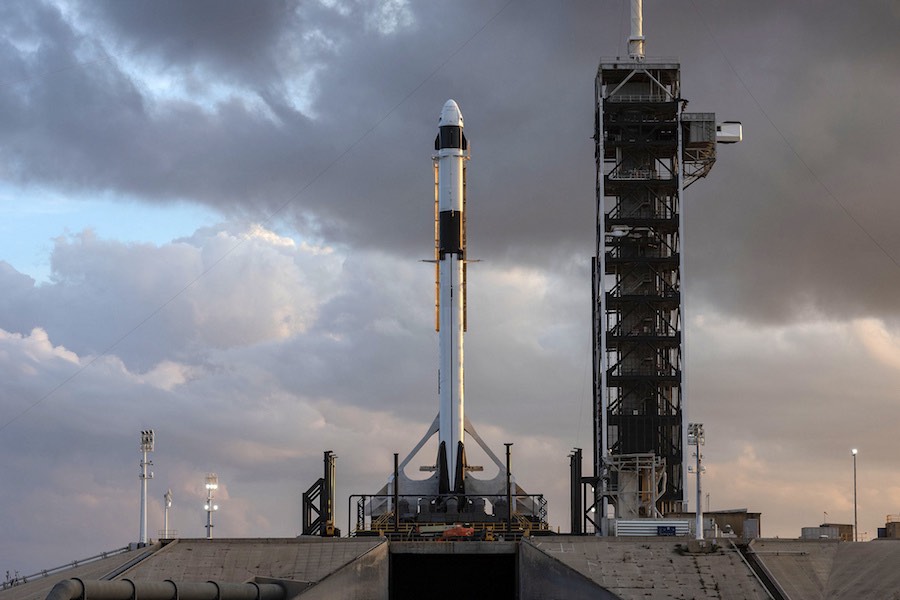
Several more Falcon 9 launches from Cape Canaveral this year are set to loft geostationary communications satellites, beginning with PSN 6, a video, voice and data relay craft for the Indonesian operator PT Pasifik Satelit Nusantara. The PSN 6 satellite, manufactured by SSL, is set for liftoff from Florida as soon as mid-February, along with a privately-developed lunar lander built in Israel named Beresheet, the Hebrew word for “genesis.”
Other commercial geostationary communications payloads that could be ready to launch on Falcon 9 rockets this year include the Amos 17 satellite for Israeli-based Spacecom Ltd., scheduled for liftoff some time between April and June, and the JCSAT 18/Kacific 1 high-throughput broadband satellite with Asia-Pacific coverage set for launch in the third quarter of the year — between July and September.
The SXM 7 satellite for Sirius XM Radio could also launch in late 2019 or early 2020 on a Falcon 9 rocket.
In addition to the flights from SpaceX’s two Florida launch pads, up to four more Falcon 9 launches are planned from Vandenberg Air Force Base in California this year, following Friday’s mission for Iridium.
SpaceX’s next launch from Vandenberg will carry Canada’s Radarsat Constellation Mission, a set of three identical radar imaging satellites, into orbit aboard a Falcon 9 rocket. Two more Falcon 9 launches from California this year are slated to deploy a fleet of German military radar imaging satellites, and Argentina’s SAOCOM 1B radar observation satellite is also scheduled for a Falcon 9 flight as soon as late 2019.
SpaceX also plans an in-flight atmospheric abort test of the Crew Dragon spacecraft in the coming months before the first astronauts fly the ship into orbit. That test flight from NASA’s Kennedy Space Center will use a standard Falcon 9 rocket — other than the lack of a second stage engine — launched from pad 39A, and the Crew Dragon capsule will activate its escape thruster pods approximately a minute after liftoff, then parachute into the Atlantic Ocean while the launch vehicle is expected to break apart after the abort command.
Twenty-one Falcon rockets took off in 2018, all successfully. That marked an increase from 18 Falcon rocket missions in 2017.
SpaceX has launched 40 straight successful missions since losing a Falcon 9 rocket in a launch pad explosion in September 2016.
This year’s launch schedule will see a change in the types of missions SpaceX is launching, a shift also seen in the wider commercial launch industry.
Missions carrying large telecommunications payloads toward geostationary orbit, a perch more than 22,000 miles (nearly 35,000 kilometers) over the equator, used to be the most common type of commercial launch. SpaceX conducted seven launches into geostationary transfer orbit in 2017, followed by eight such flights in 2018. This year, only four or five geostationary launches are on SpaceX’s manifest.
Rideshare missions carrying groups of smaller satellites are now more common, as national Earth observation programs and commercial “mega-constellations” take off.
Iridium poised to debut new services
With a modernized fleet of satellites now in space, Iridium is set to enter a new era with expanded capacity, new services, and a shift from spending money on development to earning revenue.
Iridium’s communications network operates on 66 active satellites spread among six orbital planes, plus spares, with inter-satellite radio links to relay voice and data traffic without connecting through ground stations on Earth.
The company’s first-generation “Block 1” satellites, built by Lockheed Martin, launched from 1997 through 2002 and were designed for seven-year missions. The bulk of the fleet far outlived that lifetime projection, and the new satellites have a double mission as replacements for the company’s aging and outdated 1990s-era constellation, and as vehicles to introduce new services to expand beyond Iridium’s bread-and-butter telephone and message relay functions.
The satellites launched Friday headed into Plane 3 of the Iridium fleet, and the liftoff was timed to the second with an instantaneous launch window to precisely place the payloads in the correct orbit.
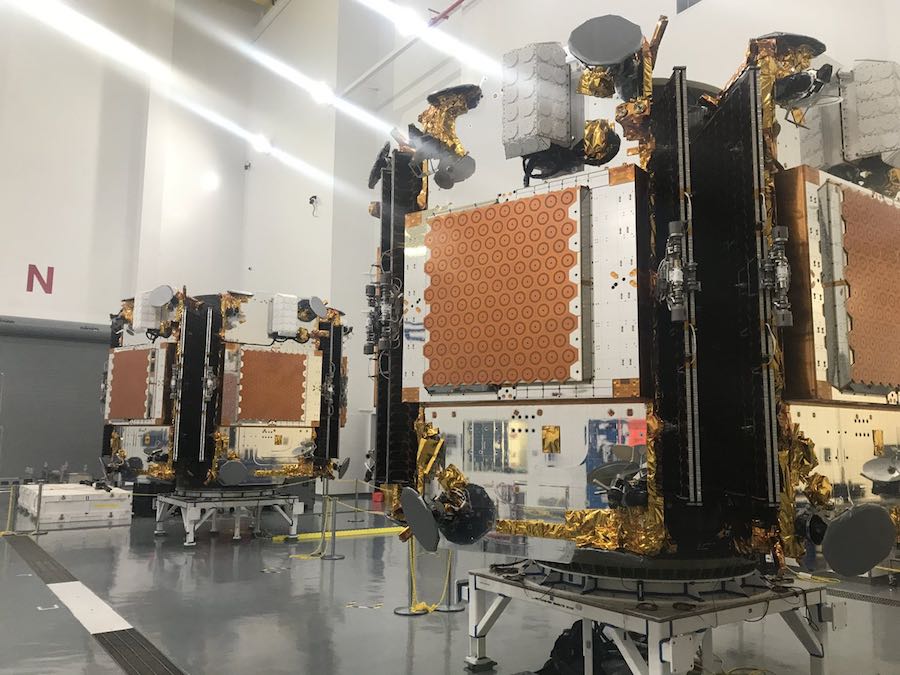
One of the new Iridium services, named Iridium Certus, will permit customers to transmit and receive higher-bandwidth messages, including high-definition video and Internet connections. Designed for ships, airplanes and other users on-the-go, Iridium Certus will provide Iridium customers with up to 1.4 megabits per second of L-band connectivity, up from 128 kilobits per second available with the previous generation of satellites.
Each Iridium Next satellite also hosts a host radio receiver for Aireon, an affiliate of Iridium established in partnership with air traffic control authorities in Europe and Canada. The Aireon instrumentation will track air traffic worldwide, including planes traveling outside the range of conventional ground-based radars.
“We broke ground on Iridium Next back in 2007, and we got started in earnest in about 2010. There was a lot of excitement when our first launch finally occurred two years ago on Jan. 14, 2017, which was amazing and very important. But our final launch… is by far the most important milestone of all.” Desch said.
“I’m sure you can imagine some of the reasons why,” he continued. “The completion of a $3 billion network refresh, the new services that we’ll be able to launch like Iridium Certus broadband, more efficient IoT (Internet of Things), and Aireon, the financial transformation it will enable for Iridium. But to me, this launch symbolizes something even more important. It means finally realizing the dream that the founders of this system had more than 30 years ago. It means our network will finally achieve the financial independence and the security that makes a satellite network operator mature and successful, and creates a lot of opportunities for us that we’ve never had before. This is a big deal for our customers, our partners, and frankly, for the industry itself.”
Originally backed by Motorola, Iridium was a pioneer in the space and communications industries, fielding the first commercial satellite fleet of its size in orbit. But Iridium declared bankruptcy soon after launching its initial batch of satellites. A new company formed to take over Iridium’s assets, including the satellites already in space, with a new business strategy after high prices and weak demand doomed the original Iridium concept.
Iridium now counts more than a million subscribers on its client list, and the U.S. Defense Department is one of the company’s core customers, along with aviation and maritime operators, ground transportation providers, and users in the mining, forestry and oil and gas industries.
“What’s next after Iridium Next? That answer is a lot,” Desch said. “The first new service we’ll be introducing is our special L-band broadband service branded as Iridium Certus. The name Certus is actually Latin, and it means reliable, determined, sure and certain, all adjectives we believe well-define Iridium and our new unique broadband service.
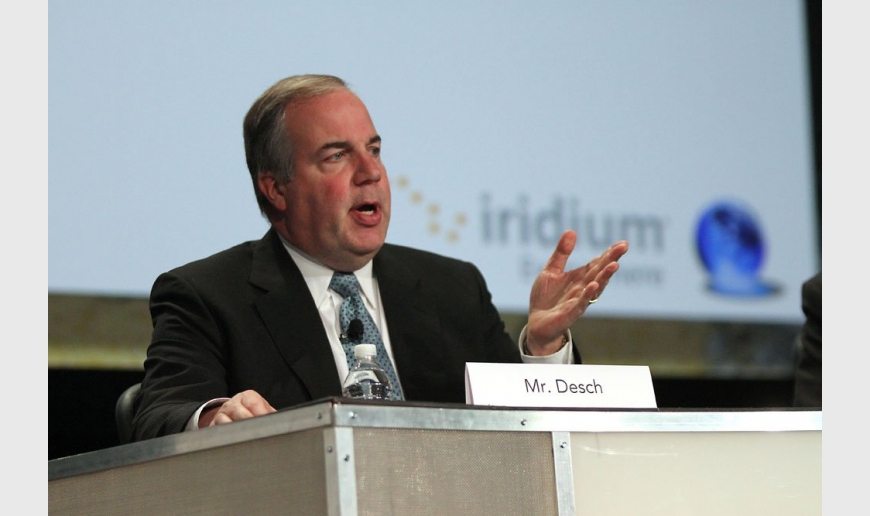
“We spent all of 2018 testing and getting Iridium Certus ready for the market, and the data trials are nearly complete. In fact, they are complete for some of our service providers, who are already starting to provide the service to their maritime customers ahead of the official commercial launch. That official launch of Iridium Certus is very imminent.”
Desch said the Iridium Certus offering will provide “safety-of-life” broadband connectivity for maritime crews and pilots. In a conference call with reporters last week, he suggested Iridium’s new L-band broadband service will not compete with high-throughput geostationary satellites and planned “mega-constellations” of hundreds or thousands of low Earth orbit spacecraft in Ka-band and Ku-band, which are aimed at the individual consumer market.
“Iridium Certus is applicable to ever industry vertical, from maritime and aviation to land mobile, and the Internet of Things,” Desch said. “We’re focusing the service on safety-of-life applications and other important specialty broadband applications. We think that’s about a $700 million market today, that we’ll be entering, primarily served by one satellite operator (Inmarsat), and we think our service will be superior in every way.”
Internet of Things is an industry term for when a type of network that relays data, measurements and other signals between numerous objects around the world, everything from remote weather buoys to critical shipments traveling by road, sea, or air.
“Iridium Certus is not designed to compete with high-throughput satellite mega-constellations, or anyone using Ka, Ku, or other bands,” Desch said. “Iridium Certus is complementary. For example, in maritime applications today, L-band terminals are often installed as a companion to VSAT (Ku- or Ka-band) terminals on-board for coverage and safety purposes.”
In its favor, L-band communications typically require a smaller ground receiver than Ku- or Ka-band, and L-band is less susceptible to interference from rain, fog and storms, making it ideal for critical services. But Ku- and Ka-band offer higher bandwidth than L-band.
“In aviation applications, Iridium Certus will be in the cockpit providing operational and safety communications at optimal levels, while Ka- and Ku-band will be in the cabin for everyone to use the WiFi for entertainment services,” Desch said.
From their initial 388-mile-high deployment orbit, the Iridium Next satellites will use their own thrusters to climb into a higher 476-mile-high (780-kilometer) to orbit, where six of the new spacecraft will rendezvous with the last of the old Block 1 satellites. Ground controllers at Iridium’s network operations center in Leesburg, Virginia, will instantaneously switch traffic from the old satellite to the new craft without interruption to commercial service, in a procedure the company calls a “slot swap.”
The other four satellites launched Friday are destined to be spares in the Iridium fleet.
“This will bring the total number of new Iridium satellites in orbit to 75, and after a thorough testing and validation process lasting several weeks, we will officially complete our new constellation,” Desch said before the launch.
Engineers are deactivating Iridium’s retiring satellites as the new relay stations arrive in orbit. Most of the old satellites have been maneuvered out of orbit to fall back into Earth’s atmosphere, and all will undergo a procedure known as “passivation,” in which their batteries and propellant tanks are drained, rendering them inert and reducing the chance of an explosion in the future.
Iridium flares, a popular phenomena for sky-watchers over the last 20 years, will end when the last of the old satellites is retired. The Lockheed Martin-built Iridium satellites have silver-coated Teflon antennas that behave like mirrors, reflecting sunlight down to Earth just before sunrise and just after sunset.
The flares are predictable — to the second — and the satellite briefly becomes one of the brightest objects in the night sky. Sky-watching apps and websites can provide the times of upcoming Iridium flares anywhere in the world.
The Iridium Next satellites designed by Thales Alenia Space have a different antenna shape that does not produce flares.
“It’s a sad time for the global flare-watching community,” Desch said. “That will be gone.”
Aireon preps for air navigation trials in the North Atlantic
The aircraft tracking service managed by Aireon will also take a big step toward starting operations with Friday’s launch.
Aireon says its service, which uses Harris Corp.-built receivers to collect aircraft position data, will ensure air traffic controllers know where airplanes are around the world, reducing blind spots in busy transoceanic routes, improving safety and fuel efficiency.
Air traffic authorities in Canada, Ireland, Italy, Denmark and the United Kingdom are part of the Aireon joint venture with Iridium, and air traffic management organizations in Africa, the United States and elsewhere in Europe are also preparing to use the system.
“With the complete Iridium Next constellation, Aireon will have real-time air traffic surveillance data comparable to that of ground systems, but for the entire planet, including over the oceans and remote areas where it has never existed before,” said Don Thoma, Aireon’s CEO.
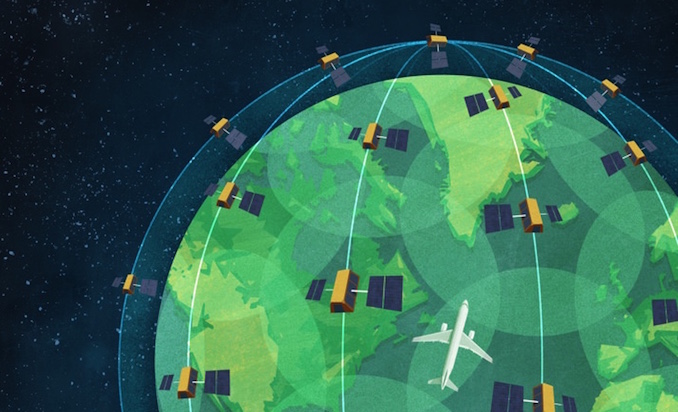
The Aireon system works by gathering position data broadcast by aircraft fitted with ADS-B technology. The Automatic Dependent Surveillance-Broadcast, or ADS-B, technology allows an aircraft to determine its location via satellite navigation, then immediately broadcast the position.
That reduces air traffic controllers’ reliance on antiquated tracking radars to follow aircraft movements. But ADS-B receivers on the ground have the same limitations as radars — they do not allow for uninterrupted tracking of airplanes over oceans and other remote regions.
When airplanes fly out of radar range, pilots are typically instructed to maintain a certain course and altitude, ensuring 30-to-100 miles (about 50-150 kilometers) of separation between aircraft for safety purposes. With real-time global monitoring, those requirements could be relaxed.
The Aireon receivers on each of the Iridium Next satellites are designed to pick up the same ADS-B signals already transmitted by most airplanes. U.S. and European regulators have required all commercial passenger airliners to be equipped with ADS-B technology by 2020.
“This was the driving reason behind the creation of Aireon,” Thoma said. “It has been clear for many years that a complete and truly global aircraft surveillance system is a must-have, not only for the efficiency of air traffic management, but for the safety of everyone traveling by plane.
“Aireon will support important improvements to safety, including improved controllers situational awareness, reducing … aircraft separation, and eliminating safety gaps due to lack of real-time surveillance,” Thoma said. “It will reduce controller response time to normal situations, such as weather deviations or navigation errors by pilots, and of course, it will improve search-and-rescue response times.
“Use of Aireon will enhance air traffic efficiencies through optimized flight paths and improved traffic flows. Real-time surveillance will allow the airlines to plan and fly more direct routes, saving substantial amounts of fuel.”
According to Thoma, certification of the Aireon system should be complete by March, allowing operational trials using satellite-based ADS-B position data to begin in April in the North Atlantic Ocean for the busy air travel corridor between North America and Europe.
Canadian and British air traffic authorities will oversee those trials, while the Federal Aviation Administration is looking at conducting similar operational testing in the Caribbean.
“The final launch is very significant Aireon,” Thoma said. “The delivery of the last 10 payloads to orbit will finally complete the Aireon network, and once the Aireon payloads are integrated into the constellation, our team of engineers and launch customers will complete a series of testing to provide the final validation and certification of the system for operational use for air traffic control.”
Email the author.
Follow Stephen Clark on Twitter: @StephenClark1.

